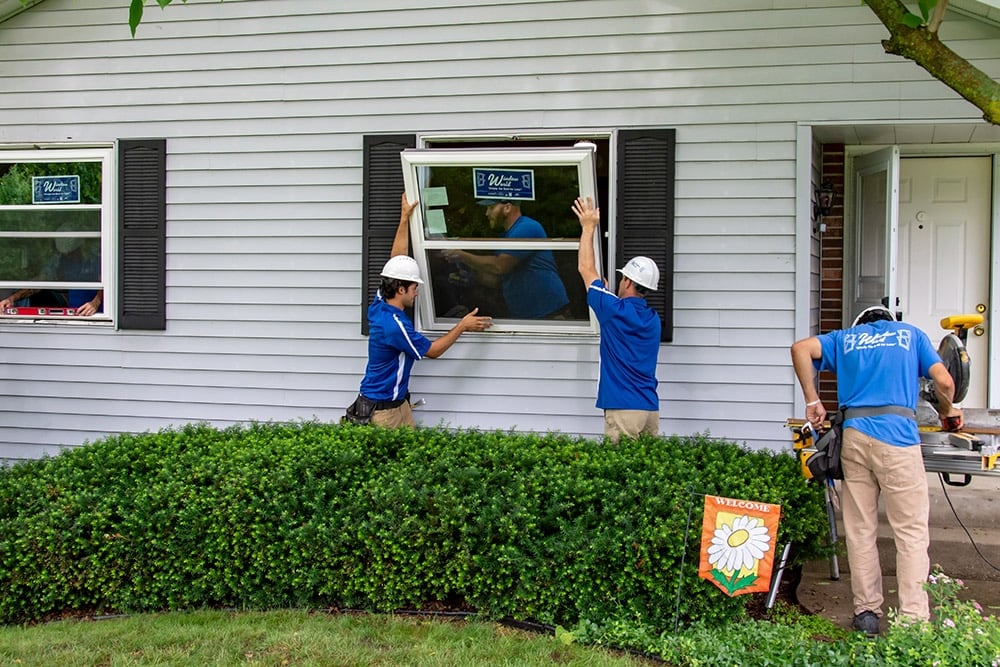Many modern windows, doors, siding and other products have energy-efficient features that keep your space comfortable, reduce appliance strain and save money. They can be valuable features in your next home upgrade, though part of the process means navigating technical language about energy efficiency and its benefits.
Words like U-Factor, R-Value and Visible Transmittance (VT) may be unfamiliar, but they’re key performance features of home replacement products. We’re here to help you make sense of it all. Keep reading to learn the meanings behind common terms associated with energy-efficient home updates.
Why Energy Efficiency Matters in Home Upgrades

Consider how much costly energy escapes your home through old, damaged single-pane windows, drafty entryways, uninsulated siding, and other cracks and crevices. That’s energy you could have used to keep your space comfortable, but instead it (literally) went out the window—and so did the money.
Replacing outdated features with newer, sustainable models helps save energy and lower bills. Less energy waste also makes your home more comfortable by eliminating drafts and cold spots. Plus, energy-efficient features can improve property value. So, when it’s time to list your home, you may already have a big selling point in place.
Key Energy Efficiency Terms to Know

You can’t just choose any “green,” “planet-positive,” “energy-friendly” or “eco-conscious” item and hope it delivers results. Understanding a few energy efficiency terms can help you choose the right home upgrade solutions.
1. U-Factor
U-Factors, or U-Values, measure the rate of heat flow through an object. They indicate how well a door, window or insulation allows heat into your home. A lower U-Factor means less heat enters your home, which is good if you want to keep your home cooler in warm climates.
2. R-Value
The R-Value (R-Factor) is somewhat similar to the U-Value, but it measures how well your insulation keeps heat in or out. The higher the R-Value, the better the insulation.
3. Solar Heat Gain Coefficient (SHGC)
Your SHGC measures how much solar radiation passes through your glass to enter your home as heat. Glass with a lower SHGC allows less heat in.
4. Low-E Glass
Low-E (Low Emissivity) glass has a microscopic coating that optimizes heat flow into and out of your home. In summer, it keeps heat out by reflecting strong rays. In winter, it allows maximum natural light in and provides more natural heating.
5. ENERGY STAR® Certification
The ENERGY STAR program—backed by the U.S. Environmental Protection Agency (EPA)—helps consumers identify energy-efficient products by applying its blue star label to items that meet certain standards.
6. Air Leakage (AL Rating)
Drafty windows can let air (and wasted energy) escape your home. AL ratings are assigned based on how well your product’s design prevents air escape. They show that the item’s cracks, crevices and shapes aren’t going to drain too much energy. The lower the rating, the less energy escapes through your product. Your HVAC, furnace or other systems will work less to heat or cool your home, saving you money.
7. Visible Transmittance (VT)
Your VT rating indicates how much visible light your windows allow in. A higher VT means more light (and heat) enters your space. Having the wrong rating for your space might increase your energy use (e.g., if you have to use more electricity because of insufficient natural light).
8. Argon/Krypton Gas Fill
Many modern, double-paned windows contain thin layers of inert gases like argon or krypton. These gases insulate better than regular air found in some products. If you choose a window with such filling, you’ll often achieve less energy loss.
9. NFRC
The NFRC, or National Fenestration Rating Council, is an independent non-profit that tests and certifies products’ energy efficiency ratings. An NFRC label appears on all ENERGY STAR windows and doors, and contains information like U-Factors, SHGCs, VTs and AL ratings. Many labels also contain maps that show the regions where a given product performs most optimally.
How These Terms Apply When Updating Your Home

When choosing energy-efficient replacement doors, windows, siding or other features, you’ll often encounter various energy ratings for the same product. The goal is to find the best balance of each rating for your home, which can vary by customer.
For example, if your house gets a lot of sunlight, you might need a window that allows in less natural light and heat. This will require choosing an option with a lower SHGC or VT rating. While sacrificing some natural light, you’ll still prevent your space from heating up too quickly and overburdening your HVAC system.
Mistakes To Avoid When Weighing Energy Efficiency Ratings
Of course, as you seek to find the right balance of energy efficiency ratings for your home upgrades, there are several common mistakes to avoid.
- Don’t simply choose an item with the highest or lowest corresponding energy efficiency ratings. This may not be the best product for your specific home. For instance, windows with the lowest VT value might block maximum light and natural heat. However, this might increase your reliance on electricity and artificial heating, which could prove costly.
- Always weigh your local climate when considering product ratings. People in warmer, sunnier climates like the Deep South often need windows that allow in less heat and light while providing insulation to keep cool air in and humidity out. Choosing a product that offers solid protection year-round is a more effective way to conserve energy.
- Work with a professional installation team. Improperly installed items may fail to function optimally, maintaining or even increasing energy waste.
Where to Find Reliable Energy Efficiency Ratings

It’s usually easy to find energy efficiency information to guide your home upgrade choices. Places to look include:
- Manufacturer specification sheets.
- The ENERGY STAR website.
- Online product descriptions.
- The NFRC label on many replacement windows and doors.
Once you have a better picture of the data, you can decide which replacement product is more likely to provide the maximum energy efficiency benefit.
Choose Window World For Reliable Energy Efficiency
Window World practices what we preach regarding energy-efficient home products. As an ENERGY STAR partner, we’re committed to designing and delivering items that keep you comfortable, save money, reduce energy use and improve property values. If you’re ready for home improvement that creates better living without the waste, we’re the team that delivers. Get your free quote on quality home upgrades today.